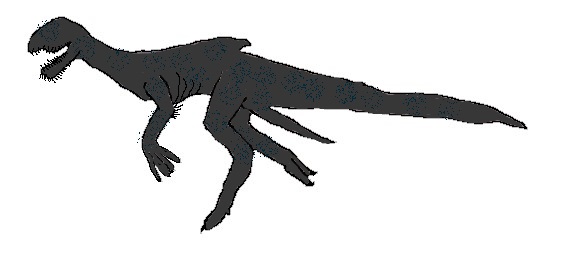Scrabla
This large predator is a pack hunter, chasing down giants such as the Sand walker, but still not going anywhere near a Shredder. Their large skull allows them to ram and butt prey, similar to a Rammer or some dinosaurs, like a Pachycephalosaurus.
Basic Information
Anatomy
They resemble a large carnivorous dinosaur in body type. It has two long legs, each with two main toes and a dewclaw. Their arms are an interesting weapon, being able to hold their weight as they hang on the side of prey.
Biological Traits
Their main weapons are their feet, hands and head. Their feet have large claws used to 'unzip' prey. Their hands are small, but strong, allowing them to climb on to a prey animal's back and claw away from there. The head can ram into the prey's side, or can bite down with extreme force. There is also some evidence suggesting they have a sort of venom.
Genetics and Reproduction
They have strange breeding habits. Their young are parasitic, being laid on a living creature, another reason they are rare. They must be laid ON A LIVING CREATURE! For a 20 foot-tall monster, not an easy task. Almost immediately after laying, the eggs hatch and the strange, worm-like larvae bore into the host's (usually a sand walker's) body, where it feeds and grows until it is an adult.
Growth Rate & Stages
While inside the host, the larvae go through many stages, growing a larger body at each shed. First comes the neck, then the back sail, then the limbs. The whole process takes a few years, leaving the walker to a slow and painful death.
Ecology and Habitats
The perfect home for this creature would be wide open plains and room to run down prey. If possible, they dig a shallow depression in the ground when they rest.
Dietary Needs and Habits
If they can find a pre-killed walker, due to age or just life in the desert, they will gladly eat it, along with the Sail runners that are desperately trying to escape. A meal like that would last them almost a year, as their metabolism is slower than most creatures their size.
Biological Cycle
Once a year, they shed their skin entirely, a day-long process. At this time, their pack mates patiently wait their turn to shed, while keeping watch for any threats to their partner.
Additional Information
Social Structure
The usually hunt in packs of 2-5. These creatures communicate is terrifying roars or screams, one of their calls giving them their name. They have a part of their head, where eyes would be that vibrates when they get excited, either making a sound out of our hearing range, or just a weird quirk.
Domestication
No attempts have even been considered.
Facial characteristics
Their face is mainly smooth, but on the lips, there are many small bumps and spikes.
Geographic Origin and Distribution
These monsters are only found in the Crystal Sands, and very very rarely, some are found in the jungles behind the mountains.
Average Intelligence
Not much better than a wolf.
Perception and Sensory Capabilities
Their large skull houses their nasal passages, which in turn, provides an amazing sense of smell 50 times that of a bloodhound. Along with most of the Crystal Sands creatures, it is eyeless, but has amazing hearing also.
Symbiotic and Parasitic organisms
Other than being a parasite, as adults, they often get external parasites around their hands and feet.
Scientific Name
Calor Venari
Origin/Ancestry
Developed withing the desert, along with the prey animals.
Lifespan
Roughly 100 years.
Conservation Status
They are a rare find, but when you find them, you'll know. They are mainly rare because they breed slowly, not because they are hunted.
Average Height
25 feet for males, up to 30 for females.
Average Weight
5 tons on average.
Average Length
At least 50 feet for adults.
Average Physique
Slim, skinny and creepy pretty much sum it up
Body Tint, Colouring and Marking
Nearly all black, with hints of blues, strange for a desert animal, but a good adaptation for cold nights. Their arms, lower jaw and back are covered in small feather-like fringes, these may be for communication somehow, or water collection like the walkers.
Remove these ads. Join the Worldbuilders Guild









Comments